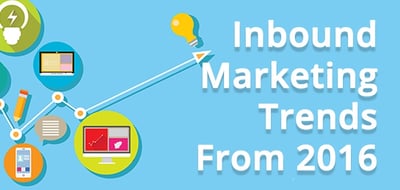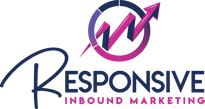13 Excellent Inbound Marketing Trends From 2016
Trends can fade away quickly, but sometimes they can also stick. In the marketing world, the accelerating changes to technology, strategies and platforms jibe with trends that rise above the rest and prove to be an important way to reach our audiences. 2016 may be over, but the following inbound marketing trends are lasting, and evolving. Be prepared for an even stronger year of marketing by incorporating these trends into your strategy. 
- Serial Content
Storytelling is a powerful marketing technique to capture your audience’s attention. Serial content tells a story through related pieces of content over time. Each part of the series relates to the previous parts (just like TV episodes), which will keep people interested and following along. Serial content also works better when it is distributed in smaller pieces, think short social media posts or videos versus an in-depth blog post. A great example of this is Kate Spade Miss Adventure.
- Personalization
A study by Accenture found that 56% of consumers are more likely to use a retailer or service if they are given a personalized experience. HubSpot found that personalized calls-to-action have a 42% higher conversion rate. Clearly personalization works. People expect a customized experience, and when you deliver relevant messaging and a user experience based on the individual, you’ll see better results.
- User-Generated Content
Do you skim through the reviews before making a purchase on Amazon? User-generated content in the form of feedback and reviews is invaluable, because people are interested in what their peers have to say, and it does influence the decision to purchase. Your audience views this content as authentic, because it is not coming from someone paid to promote the brand.
You can also leverage user-generated content to tell the story of how real people are using your product. GoPro does this well. Social media campaigns around a hashtag which is a great way to collect user-generated content.
- Influencers
Just as people read reviews before making a purchase, they are more likely to be interested in what an influencer has to say about a product. Influencers have built a relationship with their audience, and people trust what they have to say. When using influencers as part of your marketing, the content should not be a blatant ad. You still want relevant and authentic content. Another benefit of working with an influencer is receiving access to their audience.
- Snapchat
The use of Snapchat as a marketing platform is one of the inbound marketing trends that is sticking and becoming more important. Because the content has an expiration date, it adds a sense of urgency and exclusivity. People want to see it before it’s gone. Snapchat allows for marketing in real time, and has a feeling of authenticity to it because there is no ability to edit. This is a great way to show your audience the human side of your company.
- Video Marketing And Live Video
In 2017, video content will represent 74% of all internet traffic. It’s become pretty clear over the past few years that video marketing is an important component of any marketing strategy. Live video streaming gained popularity in 2016, and will continue to grow. People are looking for authenticity, not just branded messaging, so don’t be afraid to experiment. Live video speaks to people’s desire to connect with the human side of brands and companies.
- Location-Based Marketing
With the dominance of smartphones, location-based marketing fits in with a mobile strategy, and is a way to personalize your audience’s experience with real time offers and information. Whole Foods uses this technique so that when someone walks by the store, and also if they walk by a competitor's store, they get a targeted ad or promotion to lure them inside. Companies can also use beacon technology while a customer is in a store to share promotions and messaging designed to guide them to a purchase.
- Virtual Reality
One of the inbound marketing trends that marketers are still trying to figure out how to best use is virtual reality, but it’s definitely on the rise. Virtual reality can be used to demonstrate a product or to create a branded entertainment experience. Lowe’s is using VR in some stores to let customers see what a project will look like once it's finished. The customer picks out fixtures, paint colors, flooring and whatever else they need, and then see everything within the actual dimensions of their space. They can take the design home with them and view it there using Google Cardboard.
- Marketing Automation
For busy marketers, anything that can save some time is a good idea. The use of marketing automation has been growing which automate repetitive tasks and help make your team more efficient. Marketing automation can assist with lead nurturing and workflows, lead scoring, landing page creation, email list segmentation and help you to measure ROI. This frees up your team to focus on what’s really important.
- Visuals
Humans are visual creatures. We can understand images faster and retain them better than text alone. Good visuals in your marketing get people’s attention and make them more likely to consume and share your content. Infographics get liked and shared 3x more than other types of content (HubSpot).
- App-Based Marketing
App-based marketing can take your mobile strategy to the next level. 85% of the time people spend on their smartphones is while using an app. Apps open up the potential for push notifications and sending messages to people while they are using the app. Your app should not just be a mobile version of your website. There’s a reason people use their banking app and not just the bank’s mobile site. Focus on the tasks that are most important for people to be able to accomplish. And don’t forget app store optimization so that your app can be easily found.
- Mobile
Mobile is really non-negotiable at this point. Google has made this pretty clear with their mobile-first index; people use their phones to access the internet more than on a desktop. If you want to reach your audience where they are now, then look no further than the phone that is always in their hands.
- Paid Social Promotion
Getting found on social media organically used to be pretty simple. However, social media has changed, and your company’s content may need a boost to be seen by your audience. Paid promotion of social media posts became more of a necessity in 2016. Pinterest advertising is starting to take off, and Instagram has also recently introduced paid posts. But remember, with inbound, paid promotion should still contain interesting and engaging content for your audience.


